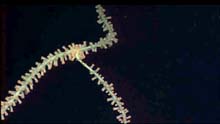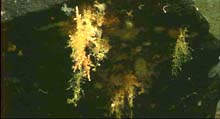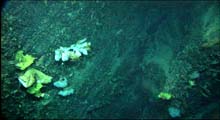
A close-up view of the polyps of the bamboo coral Keratoisis. You can see the white skeleton running through the transparent tissue. The pink spots are the oral end (mouth end) of the polyp, and in this photo the tentacles are retracted. Click image for larger view and image credit.
Go West
Goodbye and So Long to Goode, Kükenthal and the Corner Rise Seamounts
August 28, 2005
Rhian Waller
Woods Hole Oceanographic Institution
![]() See a video of how scientist process specimens. (Quicktime, 2 Mb.)
See a video of how scientist process specimens. (Quicktime, 2 Mb.)
The end to an all too brief, but fulfilling, whirlwind tour of the Corner Rise, finds us heading west towards Nashville to investigate the eastern most seamount on the New England Chain; yet again unexplored territory. But what secrets did the Western Corner Rise reveal to us? What theories proved true and which were flout?
Goode and Kükenthal, the two peaks of the Western Corner Rise, have yet again tested the limits of our assumptions about this group of seamounts. Our three dives started with Goode peak, which is on the eastern end of Western Corner Rise. This dive showed us large sediment ponds with rock outcrops creating 'oases' covered in sponges and corals. It was very similar to previous dives, yet also revealed more species that we usually see on the New England Chain. Creeping that little bit closer to western fauna, yet still distinct, with little current flow allowing the import of larvae or food into the area and a lower diversity than we see further west.
The second dive (our eighth) visited the top plateau of Kükenthal, the western peak. This dive revealed a completely different bottom than anything we had seen before, either on the Central or Eastern Corner Rise, or the New England Seamount chain. Even on landing we saw more species of fish than we had on the previous dives combined, a large wall etched with the marks of sponges and corals now absent, and large crabs scurrying into holes after waving their claws at the Hercules invader. Though this seamount turned out to have few faces unscarred by the dragging of fishing gear (see ' Fisheries Impacts on Deep-Water Corals'), and yielded few samples, we did see, for the first time on the Corner Rise, signs of the colonial coral Lophelia pertusa , the most abundant deep-water hard coral in the world.

Though this is most abundant deep-water hard coral in the world's oceans (Lophelia pertusa), this tiny piece on an overhang is the first sighting we have had on this cruise. Click image for larger view and image credit.
I'm certain I will not be alone in saying dive nine will forever be etched into memory as one of the most spectacular I will ever see. 22nd August 2005, 3.30pm, 1850m down, faced with a wall as far as the eye can see, covered in corals, live and fossil, and more types of sponges than we could count. Starfish, crabs and urchins defying gravity, clambering up the sheer rock face. Completely breathtaking. This wall revealed both new species of corals and species we have not recorded at the Corner Rise on previous dives. We could have spent many more hours there than we did, but Hercules was straining under the weight of samples. Akin to Christmas on deck at 12pm, scientists diving into the bio-boxes, unwrapping their presents under the Hercules tree, and many happy faces. Even after the 8 hours of processing it took to preserve the precious cargo, we were all still smiling. This has been by far the most revealing dive on the Corner Rise, and the perfect finale to our series of dives in this area.
The Corner Rise exceeded many of our expectations, revealing habitats and species that none of us predicted. A unique combination of east and west, with a much lower current, lower diversity and higher sedimentation than we expected to find. Yet as we leave, we all contemplate that we have merely scratched the surface of what any of these seamounts have to offer. With just 9 dives on an area larger than Massachusetts, each covering a mere kilometer, the Corner Rise has many secrets yet to be revealed.
Sign up for the Ocean Explorer E-mail Update List.


























